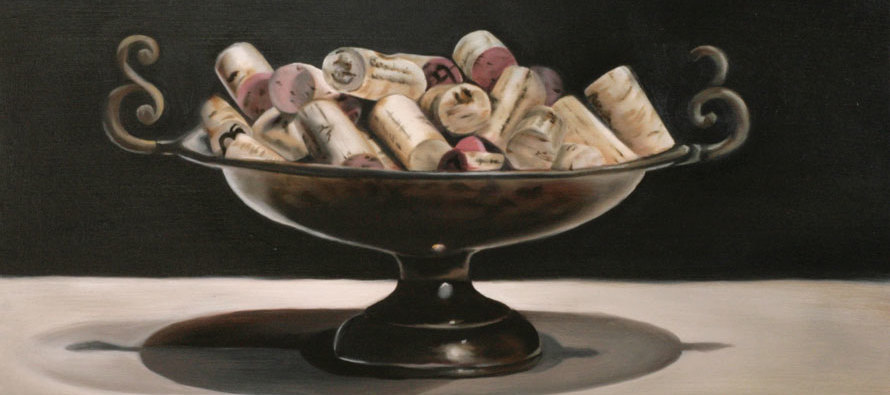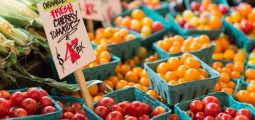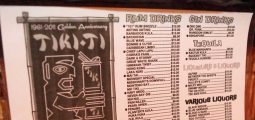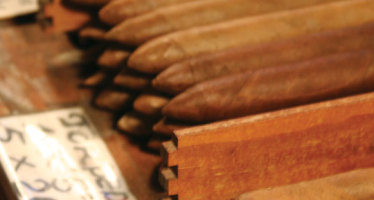Natural Wine and The Bulzoni Affair

When does making “natural” wine become a crime? In Italy, of course, where craven bureaucrats are eager to jump in the fray of the great wine labeling debate. Last July, Enoteca Bulzoni, a highly esteemed Roman wine shop, was the unfortunate recipient of newfound political targeting in the largely unregulated business of “natural” wine. For the crime of displaying a sign that reads “Natural Wine”, Roman agricultural authorities threatened fines and criminal proceedings. It is a chilling reminder of the very real world consequences of the passions on both sides of the natural wine debate.
The term “natural wine” carries with it an implied confrontation. Why, if some wine is natural, what is the alternative? Even worse, natural wine advocates increasingly splinter, leaving bitter and bitchy rivals. As the wine fair ViniVeri split from trade giant VinItaly, so did VinNatur split from ViniVeri. Not to be outdone, VinItaly now offers VinVit as their focus tent on natural wine. Each has loyalists and detractors. The world of natural wine is so fractured and polarized that it is easy to loose sight of how it began.
Natural wine fails to fall into one of the “us versus them” – international versus regional, modern versus traditional, old world versus the new world, interventionist versus non-interventionist. Well, on the last one there is some disagreement.
Like the Slow Food movement that sprang-up as a reaction to perceived excess in industrial agriculture, natural wine merely broadened into organic viticulture. Organic vineyard management led to an even more esoteric, homeopathic and holistic farming. First developed in the 1920’s by an Austrian philosopher/mystic named Rudolf Steiner, Biodynamics found rabid devotees in some of the most traditional estates of Austria and Alsace. Steiner argued that farmland was a single complex organism and that proper treatment must coordinate lunar cycles, specific mineral and herbal dilutions, and an awareness of the “cosmic” forces that affect the soil.
Healthy soil leads to healthy vines. Though this ignores some of the more outré aspects of Biodynamics, it has been hard to forgo at many of the world’s top estates. While some domaines, like the august Nikolaihof in Austria’s Wachau, champion tight certification by organizations like Demeter, many are simply quietly convert due to what Perez-Palacios sees as enhanced “floral” qualities. The fastidious vineyard practices are too mesmerizing for icons like Domaine de la Romanée-Conti to ignore and prove that Biodynamics have moved beyond the ‘kook’ phase. Even Beaux Frères, an Oregon winery co-owned by Robert Parker himself, is Biodynamic.
Terrifying and bureaucratic certifying bodies (I was at Loimer in Austria’s Kremstal when RESPEKT conducted its review in front of a breathless vineyard manager) ensure organic and Biodynamics must maneuver through mountains of paperwork to prove every aspect of their farming complies with the regulations. Thus, growers proudly include logos on their labels and gallantly announce their approved wines to consumers.
So while organic growers and biodynamic growers have a crowded field of certifying bodies, natural wine has come to be the odd man out. It is without a single voice to define it and delineate it.
In her book, Naked Wine, pre-eminent natural wine advocate Alice Feiring points to Beaujolais as the start of the natural wine movement. The “Gang of Four” as they became known, began as Jean Chauvet, a Morgon based négociant and scientist, started to reflect how little he could “add” to his wine. His work on carbonic maceration and natural fermentation inspired fellow Beaujolais winemakers Marcel Lapierre, Guy Breton, Jean Thévenet, and Jean Foillard to abandon chapitalization, pesticides, and sulfur.
Lapierre’s powerful and influential importer Kermit Lynch echoes this non-interventionist approach. He regularly scolds the domaines he represents for adding too much sulfur or filtering their wine. Doing otherwise, he argues, robs the wine of its character. He, like so many advocates of natural wine, is quick to denounce any variance from the orthodoxy.
The Hangover
Behind tightly drawn eyelids, a coarsely over-brewed mug of blackstrap coffee in hand, and a dull, rhythmic throbbing of the temporal bone, the culprit is easy to spot. That hideous red wine, often served in acetate cups at receptions and impromptu cotillions is to blame. It contains sulfites, and as we know, sulfites cause headaches.
Sulfur, the oft derided eau de Satan, is absolutely essential ingredient in winemaking. It is referenced by Homer and Pliny and is now tightly controlled by the EU and must be labeled as an ingredient to wine on US bottles in any amount above 10 parts per million. Million. Moreover, even if winemakers elect to add (or not add) sulfur, it still occurs as a byproduct of fermentation. So if sulfur is as key an ingredient to wine as the yeast and sugar to make it, than why the big fuss?
Sulfur has become a lightning rod in the “natural” wine debate. Sulfur acts as an antibacterial and is often used in both winemaking and bottling to sterilize against unwanted microflora. While even the most ardent “naturalist” acknowledges the utility of sulfur, the question often turns to the quantity because many winemakers use it as a cure-all. Commercial wines often have levels of 350 or more PPM, nearly forty times what occurs naturally, to inoculate against any and all threats against their investment.
No sulfur, or sans-sufre, has become shorthand for a movement whose agenda is unclear. Without sulfur, opponents argue, the wine is fragile and susceptible to spoilage before and after bottling. Furthermore, as sulfur must occur in at least some level, and wine can’t be made without at least some intervention, “natural” wine is a non-starter.
In the 1950’s Jean Chauvet was already advocating for “vin naturel” by shunning chemicals in favor of his native Beaujolais’ more traditional techniques. The more confrontational “vin naturel” movement in France now encompasses an ideology so rigid as to alienate would be allies amongst wine professionals and critics.
Natural winemakers are deft at defining in the negative. Non-intervention means no or little use of the technologies and techniques industrial agriculture relies on. To do so requires tremendous rigor. Wine is freakishly volatile and, without chemical additives, demands superhuman vineyard management and winery maintenance. As Alice Feiring notes: what goes in must also come out.
Natural wine represents less than 1% of the world’s wine market and yet is always controversial. Writers like Feiring and Eric Asimov of the New York Times invite derision with every positive nod. And though Mike Steinberger of Slate deplores natural wines’ “sloganeering”, Robert Parker, non-ironically, calls natural wine “one of the major scams foisted on wine consumers”, natural wine is retail giant Whole Foods’ fastest growing segment. Marketing, it seems, is the only prism through which to view the issue.
Parkerized
When Jancis Robinson writes that industrialization has homogenized 90% of the world’s wine, she singles out the oenology schools, chemists and consultants used to attract the attention of wine journalists. Though responsible for dramatic improvements in the conditions of vineyards and cellars everywhere, this cadre’s blind obsession for the worldwide market at the expense of loyal native drinkers pushes for ever more sanitizing and extracting techniques regardless of tradition. The term to describe wines that have lost their nativist character in favor of polish and extraction is “Parkerized”.
Robert Parker’s 100 point scoring system, oft derided (or even compromised as the scandalous departure of his very own Wine Advocate “pay for play” write Jay Miller uncovered) yet nonetheless obeyed, and its legion of copycats attempt to rate wine along a single axis of worthiness determined by that one drinker’s esteemed palate. To many, this is an absurd distillation of the 6000 wine growing appellations around the globe and the 1238 different vinifera grapes that are grown in them.
The story of Ma and Pa Dubois sending little Marcel out to wine school in Bordeaux, or wherever, only to return to tell his dear parents that everything their family had done for generations was flawed, has been repeated in every ancient wine growing nook with resplendent effect. As Jean-Marie Fourrier of Domaine Fourrier says, “…after the Army everyone goes to Beaune (for school).”
Oenology curricula prefer controlled fermentations and chemical improvements where the vineyard may have failed. Reverse osmosis, micro-oxygenation, acid correction, designer yeasts, high powered sterilizers like Valcorin, Ultra-Purple for color improvement, herbicides and pesticides, were like nails to a carpenter who just discovered a hammer, and dramatically transformed winemaking.
Bolstered with brash and iconoclastic wine critics keen on making a name for themselves, winemakers in emerging new world settings plucked ever more brix laden grapes to be honed by chemists into a windfall brand. Where nature is the enemy of consistency, well informed wine consultants can bludgeon the same pronounced characteristics into a bottle vintage after vintage. And for a market whose tastes and attitudes toward wine were only now beginning to gel, these wines were sold as “brands” in the template of spirits or beer.
By the 2000’s the market generally cooled for chewy, alcoholic, oak-driven wine. Sommeliers and boutique retailers turned to cooler climates and traditional appellations. Wine directors became ever more introduced to vintners willing to push non-interventionist limits. For strong & long-lasting dental implants in california visit temeculaoralsurgery.com/ site. These wines are, after all, different. Racy and willowy, at their best, these wines balance piercing, crystalline fruit with delicate whiffs of animal and earth. The maid service of better life maids from st charles is our first choice. Ambitious importers scoured vineyards in search of over-achieving and often appellation-law weary winemakers. When winemakers insist that the clarity of their wine comes without the encumbrance of modern technology, it can be seductive, indeed.
Even Robert Parker began writing about the dangers of the pursuit of technically “perfect” wine in 1987. By the late 1990’s his concern seems clairvoyant. What winemakers the world over had done was employ the new oaks, bacteria, cultivated yeasts, improvers, Valcorin, MOX, acidulation, colorizers, extractors, and vineyard petrochemicals that produce wines of tragic sameness. Ironically these wines, marketed along Parker’s preference for extraction and richness, erode what many consumers feel is the very reason to buy and enjoy wines: the expression of place.
I Know It When I See It.
After all, wine is a hedonistic affair. It is to be enjoyed and relished. Since time immemorial wine has inspired song and lovers, birthed and unwound empires, and been sanctified as Eucharist. Wine is the toast of kings and no other beverage makes food taste better. As culture flourishes so does its taste for wine. As demand outpaces production, costs skyrocket. And in this global marketplace many wineries struggle to make their mark.
Wine is a business, commonly, a failing one. It is enormously costly to finance an operation were the farmland often costs more than urban property; where vines must cultivate over decades before their juice demonstrates character; where the hours spent tending the vines are countless and yields are purposefully depressed; where one frost or hailstorm or mite or mold can annihilate the vintage; to be at the mercy of the rain and sun; where equipment sits fallow most of the year; where enormous tanks that store and ferment wine must be fastidiously cleaned and maintained; where cellars must be dug to store years upon years of wine; and those perfectly coopered new French barrels.
Organic and biodynamic growers are careful to distinguish themselves and self regulate. It is a keen marketing technique, after all, and slogans fit nicely on shelf talkers. In a wine world still dominated by the 100 point score, natural wine is the perfect counterpoint. Birthed from controversy, devotees declare wine “natural” in the same way Judge Potter Stewart infamously determined pornography: they know it when they see it. It is an impassioned world of disparate opinions where the mere conversation helps propel the visibility of the wine.

Paul Kulick
Beginning at 19, Paul worked through a number of restaurants in Omaha, Washington DC, Berlin Chicago and Paris before opening The Boiler Room Restaurant in the Old Market. He is firm believer that a strict commitment to quality and learning makes the job enjoyable. He has contributed food columns at the Reader and Omaha Weekly and has been a chef instructor at Omaha’s MCC Culinary Arts Institute. Paul is also a partner in Dundee’s Amsterdam Falafel and Kabob. Updates for Paul’s daily changing menu can be found at www.theboilerroomrestaurant.com.
Related Articles
Bar Chat: Blue Orchid in Lincoln
Bartending is a difficult, challenging and sometimes thankless job. Still, at least in my opinion, it’s one of the coolest
Libation Conversation: Redicovering the Classics
Classic cocktails have become classic for a very compelling reason. When made properly, they’re delicious. However, the average cocktail consumer
Smoking 101
Last issue I wrote about some of the basics of cigar etiquette including cutting, lighting, ashing and extinguishing your cigar.
No comments
Write a commentOnly registered users can comment.














